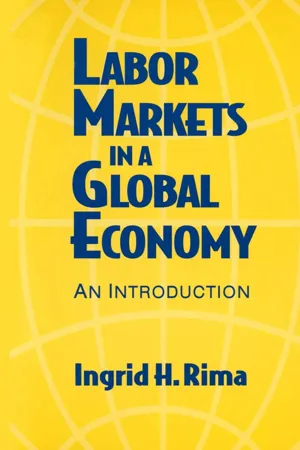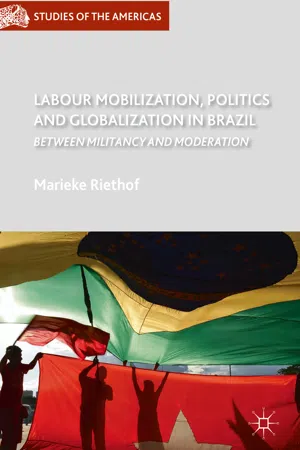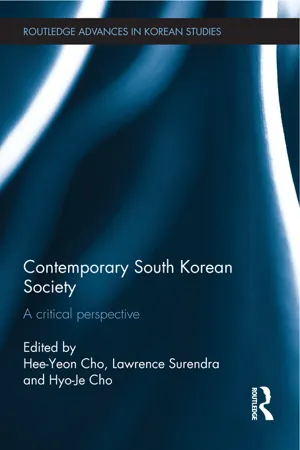Economics
Labor Movement
The labor movement refers to the collective efforts of workers to advocate for better working conditions, fair wages, and improved benefits. It encompasses the formation of labor unions, strikes, and negotiations with employers to address issues such as workplace safety, job security, and equitable treatment. The movement has played a significant role in shaping labor laws and policies.
Written by Perlego with AI-assistance
Related key terms
Related key terms
1 of 4
Related key terms
1 of 3
5 Key excerpts on "Labor Movement"
- eBook - ePub
Labor Markets in a Global Economy: A Macroeconomic Perspective
A Macroeconomic Perspective
- Ingrid H. Rima(Author)
- 2015(Publication Date)
- Routledge(Publisher)
In his “A Theory of the Labor Movement” (1928), Perlman argued that the prerequisite for successful unionization is giving up the Marxian idea of a revolutionary triumph against capitalists, to utilize unionism as a tool to achieve a social evolution toward the negotiation of collective bargaining agreements that would give workers a large measure of job control. A more recent interpretation of the evolution of the Labor Movement is the collaboration of Clark Kerr, John T. Dunlop, Frederick Harbison, and Charles Myers, Industrialism and Industrial Man (Cambridge: Harvard University Press, 1960). Their focus is on the relationship between an economy’s stage of economic development and its relationship to the kind of labor–management relationship that develops. 4. The Taft–Hartley Act of 1947 and the Landrum–Griffin Act of 1959 both restricted union activity and made it more difficult to organize nonunion workplaces. Some Southern states passed antiunion “right-to-work” laws which tried to prevent collective bargaining contracts that made union membership a condition of employment. Thus, from a legal standpoint, the tide turned in the late 1940s and the 1950s against organized labor. 5. Much of this work stems from Gary Becker’s seminal work, Human Capital (New York: National Bureau of Economic Research, 1964). 6. More recent approaches to explaining why wages stop falling when there is an excess supply of labor will be examined in chapter 3. 7. J.M. Keynes, The General Theory of Employment, Money and Interest (London: Macmillan, 1936), p. 13. 8. Much of this research builds on the work of Edmund Phelps in Macroeconomic Foundations of Employment and Inflation Theory (New York: W.W. Norton, 1970). 9. Alfred Eichner, The Macrodynamics of Advanced Market Systems (Armonk, NY: M.E. Sharpe, 1991), p - eBook - ePub
Labour Mobilization, Politics and Globalization in Brazil
Between Militancy and Moderation
- Marieke Riethof(Author)
- 2018(Publication Date)
- Palgrave Macmillan(Publisher)
The Blackwell Companion to Social Movements , ed. David A. Snow, Sarah A. Soule, and Hanspeter Kriesi, 555–575. Oxford: Blackwell.Fantasia, Rick, and Kim Voss. 2004. Hard Work: Remaking the American Labor Movement . Berkeley: University of California Press.Gahan, Peter, and Andreas Pekarek. 2013. Social Movement Theory, Collective Action Frames and Union Theory: A Critique and Extension. British Journal of Industrial Relations 51 (4): 754–776.CrossrefGledhill, John. 2000. Power and Its Disguises: Anthropological Perspectives on Politics . London: Pluto.Gómez, Hernan B. 2013. Lula, the Workers’ Party and the Governability Dilemma in Brazil . New York: Routledge.Gray, Kevin. 2007. Korean Workers and Neoliberal Globalization . London: Routledge.———. 2015. Labour and Development in East Asia: Social Forces and Passive Revolution . New York: Routledge.Grodsky, Brian K. 2012. Social Movements and the New State: The Fate of Pro-Democracy Organizations when Democracy is Won . Stanford: Stanford University Press.Hipsher, Patricia L. 1998. Democratic Transitions as Protest Cycles: Social Movement Dynamics in Democratizing Latin America. In The Social Movement Society: Contentious Politics for a New Century , ed. David S. Meyer and Sidney Tarrow, 153–172. Lanham: Rowman and Littlefield.Hochstetler, Kathryn. 2008. Organized Civil Society in Lula’s Brazil. In Democratic Brazil Revisited , ed. Peter R. Kingstone and Timothy J. Power, 33–53. Pittsburgh: University of Pittsburgh Press.CrossrefHyman, Richard, and Rebecca Gumbrell-McCormick. 2010. Trade Unions, Politics and Parties: Is a New Configuration Possible? Transfer 16 (3): 315–331.CrossrefJenkins, Steve. 2002. Organizing, Advocacy, and Member Power: A Critical Reflection. Working USA 6 (2): 56–89.CrossrefJohnston, Hank. 2011. States & Social Movements . Cambridge: Polity.Karatasli, Sahan Savas, Sefika Kumral, Ben Scully, and Smriti Upadhyay. 2015. Class, Crisis, and the 2011 Protest Wave: Cyclical and Secular Trends in Global Labor Unrest. In Overcoming Global Inequalities - eBook - ePub
Contemporary South Korean Society
A Critical Perspective
- Hee-Yeon Cho, Lawrence Surendra, Hyo-Je Cho, Hee-Yeon Cho, Lawrence Surendra, Hyo-Je Cho(Authors)
- 2012(Publication Date)
- Routledge(Publisher)
Since political democratization in 1987, the Korean Labor Movement has been able to develop its organizational and mobilizational capacities to the extent to establish itself as a legitimate social actor and institution. Based on their organizational strength, unions engaged in various actions to improve their wage levels, social protection policies, legal provisions on collective industrial relations, and formal political representation. With the formation of the Tripartite Commission and the Democratic Labor Party, in particular, the union movement seems to have gained institutionalized access to formal political processes to be able to influence labor policy making. However, unions’ participation in such political arenas produced either dubious outcomes or outcomes that were restricted to the constituency represented by the narrowly organized labor unions.New Labor Movements from within
For the past 20 years, Korean society underwent a concomitant process of political democratization and economic liberalization. Political democratization has obviously created a nurturing environment for the empowerment of the Labor Movement. However, the processes of economic liberalization and changing labor market conditions created novel challenges to the Korean Labor Movement. The size of the industrial manufacturing sector declined and undermined the traditional bases of union membership. Public and private firms underwent restructuring that often accompanied massive layoffs. Full-time jobs went through reductions only to be replaced by contingent workforce. Women have been disproportionally employed in the service sector particularly under precarious employment conditions. The number of migrant workers also soared to fill the dangerous and difficult work in small firms that Korean workers were hesitant to take.Yet, these diverse subgroups of working population lacked an adequate organizational voice to be able to affect the direction of macro- economic changes. Narrowly organized Korean unions have been inadequate in responding to and representing these labor issues stemming from the fragmented and stratified labor population. As such, a large sway of labor issues had to be pursued outside union structures. Beginning from the late 1990s, women workers, non-regular workers, and migrant workers emerged as the new sources of labor activism often articulating intersecting social justice concerns in conjunction with other social movement forces. - eBook - ePub
Theories of Trade Unionism
A Sociology of Industrial Relations
- Michael Poole(Author)
- 2021(Publication Date)
- Routledge(Publisher)
1 Early theories of the labour movementIn recent years the dearth of systematic theories of union action and behaviour has been lamented. Thus, in Trade Unionism under Collective Bargaining, Hugh Clegg not only identified such a problem but also drew attention to the paradoxical nature of this situation in a period when unions have come to be regarded as among the most powerful forces shaping our society and determining our future'.1 Yet, although we would in no way wish to dispute the uneven quality of much of contemporary theory, or to infer that any universally accepted model of trade union growth, structure and policy has any real prospect of emerging in the near future, at the same time, it is essential to recognize the long-standing tradition of interest in generalizations about trade union and labour movements. Indeed, in many instances, the germs of contemporary debates may be traced back to accounts of upwards of a century ago.The principal objective of this chapter, then, will oe to locus upon early theories of the labour movement and to locate the origins of many of the foremost of present contributions in these classical traditions. For our major categories we have based the analysis upon the classification of Mark Perlman deployed in his seminal contribution, Labor Union Theories in America2 ; although this has been adapted, of course, to take into account the distinctive British cultural context and to incorporate primarily British material. Furthermore, although it is not our view 'that writing a study covering theoretical material after 1933' is 'essentially impossible because the latter period (until now) just simply failed to produce veins of theoretical material rich enough to warrant mining,'3 - Byoung-Hoon Lee, Ng Sek-Hong, Russell Lansbury, Byoung-Hoon Lee, Ng Sek-Hong, Russell Lansbury, Byoung-Hoon Lee, Ng Sek-Hong, Russell D Lansbury(Authors)
- 2019(Publication Date)
- Routledge(Publisher)
The ILO Report on Asia-Pacific Employment and Social Outlook (2018) highlighted the barriers that exist to achieving the United Nation’s Strategic Development Goals (SDGs) by 2030. This Report also argued that economic growth in the region is built on fragile foundations and needs to be refocussed on the four pillars of the ILO’s Decent Work Agenda: promoting decent jobs, guaranteeing rights at work, extending social protection and promoting social dialogue. But there is scant attention paid in the ILO Report to the need to strengthen collective bargaining rights which can only be achieved if there are strong and effective trade unions or other forms of worker collectives which can bargain on their behalf. Labour market institutions and laws are necessary to provide workers with the ability to negotiate better wages and conditions as well as giving them a voice in managerial decisions which affect them in the workplace.This book seeks to provide an assessment of unions and other forms of worker representation in the Asia-Pacific region by examining the situation in thirteen countries. The key issues raised in relation to the varieties of labour movements in each of the thirteen countries are briefly summarised below and then examined in greater depth in the chapters which follow.Case studies from the Asia-Pacific region
In Australia, trade unions have experienced declining membership from a peak of 60% of all wage earners forty years ago to a current density of less than 15%. Various reasons have been advanced for this decline including structural change of the economy and the workforce as well as legal reforms introduced by conservative governments to curb union power. The union movement has employed a number of strategies seeking to arrest and reverse its membership decline, including union mergers and active organising drives, but these have achieved only limited success. Yet unions still exercise political influence through the Australian Labor Party, and continue to play an important role as an advocate for wage earners in industrial tribunals. Although there has been the growth of social movements which seek to advance workers’ rights, there remain major challenges to revitalise and reform the union movement. Unions in Australia have sought greater engagement with their counterparts in Asia and the Pacific, as the region becomes more economically integrated.Workers in China face a very different situation to most countries in the region, with the exception of Vietnam, as the government recognises only one trade union: The All-China Federation of Trade Unions (ACFTU) is effectively an organ of the state. However, with the decline of state-owned enterprises and the emergence of local and foreign-owned private companies, workers have engaged in unofficial strikes, particularly in manufacturing, in order to seek increased wages and improved working conditions. New forms of organisation and non-governmental organisations (NGOs) have been formed to support Chinese workers. Yet their future depends on whether the Chinese government continues to tolerate or decide to suppress alternatives to the official trade union movement and permit greater independence of the ACFTU from the state.
Index pages curate the most relevant extracts from our library of academic textbooks. They’ve been created using an in-house natural language model (NLM), each adding context and meaning to key research topics.
Explore more topic indexes
Explore more topic indexes
1 of 6
Explore more topic indexes
1 of 4




